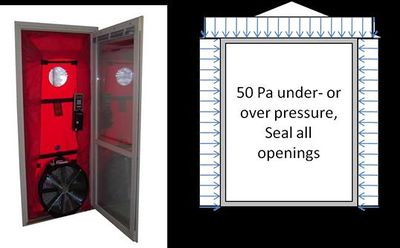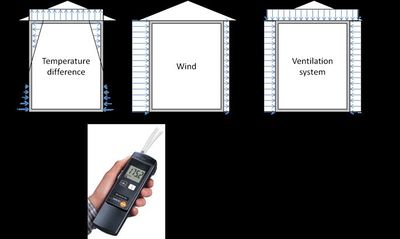Insulate background information
- The content on this page is taken from the Insulate webpage.
Buildings
Building assessment
Building assessments give information about the condition of buildings as well as on the need for and anticipated cost of renovation. Major repairs and renovation foreseen within the next five to ten years as well as need for more in-depth building inspections are typically included in the building assessment report.
Structural engineering experts as well as experts in heating, plumbing, ventilation and electrical installation are needed for performing a completed building assessment. It is usually recommended that first assessment should be performed when the building is about 10 years of age. After that, the assessment should be updated every five to ten years. Energy audits and related assessments can be performed at the same time.
Building assessments are commonly conducted as building walkthroughs utilizing checklists and other non-destructive assessment methods. While some simple measurements can be taken, the assessment is mainly based on a visual evaluation of the building’s condition and of the need for renovation. Building assessments may be further complemented by interviewing or surveying building occupants to collect information and perceptions about the building. There are some common guidelines for ordering, performing, and reporting building assessments, and in some countries, building owners may apply for financial aid to cover the costs related to building assessments.
Building inspections
If persons conducting building assessments deem it difficult to assess the condition of some parts of the building, they will propose a more detailed inspection. On one hand, building inspections give more precise and detailed information about the condition of critical parts of the building. On the other hand, they give information that will help in planning renovations and in choosing appropriate renovation methods. Typically, building inspections can focus on:
- Structures or structural components, such as outer walls, balconies, rooms with a floor gully, roofs
- Plumbing system
- Electrical systems
- Heating systems
- Ventilation systems
- Indoor environmental quality (IEQ)
Professional education and experience is required for performing these inspections. The inspector should also have proper tools and equipment for taking and analyzing samples.
The methods and procedures of the inspection vary depending on the inspection target. There are several methods and combinations of methods which inspectors can use in their work:
- Studying design plans and other documents
- Visually-based inspection
- Structural openings and other destructive methods
- In situ measurements and tests
- Illustrations and viewing of structures and piping
- Taking samples and analyzing them at a laboratory.
In the following, some structural measurements are described which can be included in building inspections that could also be related to IEQ.
Surface temperatures
Measuring surface temperatures of the outer walls helps tracking spots with poor thermal insulation, heat/cold bridges, and air leakage. Surface temperatures can be measured using thermographic camera or surface temperature meters. Surface temperature is usually presented as a thermal index (TI), which takes into account outdoor and average indoor temperature at the measurement point. According to the Finnish Housing and Health Guide (Asumisterveysohje 2003), a good level is TI ≥ 65 and an adequate level is TI ≥ 61.
Airtightness
Airtightness of the building envelope is usually determined by so-called blower door tests. The special equipment (blower door) is installed on one door and all other openings (doors, windows, chimneys, ventilation vents) are sealed. The equipment creates 50 Pascal under or over pressure into the whole building and measures leaking air. It also calculates the airtightness value, n50 or air leakage value q50. If some other value than q50=4 m3/h m2 is used for calculating the E-value of the building, the airtightness of the building should be measured. Measuring the airtightness of an entire apartment building is quite difficult and laborious work, since all openings in all the apartments should be sealed. It is also possible to measure airtightness of one apartment, but the results will not be very reliable because of some air leakages through the walls between apartments.
Air change rate=
Measuring air change rate is a basic part of an inspection of the ventilation systems. The inspection includes visual inspection of the condition and cleanness of the air channels, vents, and air supply units. If the building is equipped with mechanical ventilation, the air exchange rate could be assessed by measuring air flows from the exhaust air vents. It is quite difficult to assess the air change rate if the building has natural ventilation. In such cases, air change rate can be assessed by using a so-called tracer gas method. It is commonly agreed upon that the air change of an apartment should be at least 0.5 m3/h in all the rooms (air change rate 0.5 l/h).
Pressure difference
Balancing the ventilation is critical for managing the pressure difference between outdoor and indoor air. Also the temperature differences between the indoor and outdoor as well as the outdoor conditions, such as wind, affect the pressure difference.
High over pressure between the outdoor and the indoor may lead to moist indoor air transferring into the structures and resulting in condensation, while high under pressure may lead to all the impurities of the structures and surrounding environment (e.g. radon from the soil underneath the building) being sucked into the indoor air. Table 2 shows the acceptable pressure differences in the different types of ventilation systems, according to the Finnish guidelines. [1]
| Ventilation system | Pressure difference | Notes | |
|---|---|---|---|
| Natural | 0...-5 Pa against outdoor | 0 Pa against staircase | Pressure differences vary a lot enclosed to weather |
| Mechanical exhaust | -5...-20 Pa against outdoor
0...-5 Pa against staircase |
Pressure differences vary a lot enclosed to weather | |
| Mechanical inlet and exhaust | 0...-2 Pa against outdoor
0 Pa against staircase |
Pressure differences vary a lot enclosed to weather |

